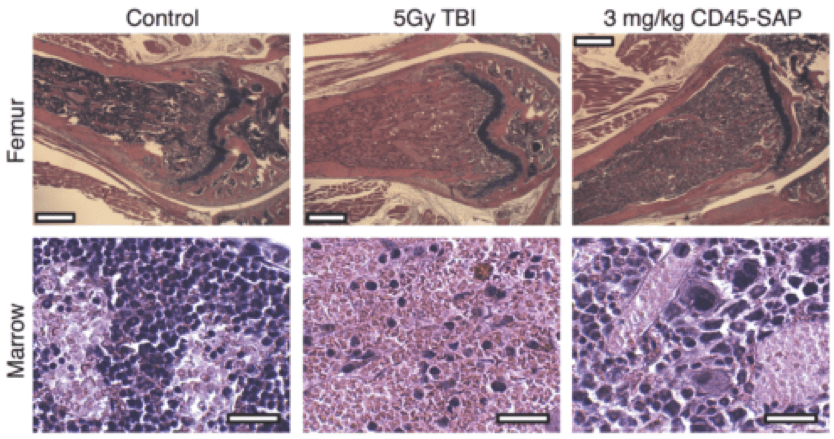Stem cell research has great potential to understand, treat and cure diseases. By watching stem cells mature into cells in bones, heart muscle, nerves, and other organs and tissue, researchers can determine how diseases and conditions develop. Here are some recent publications that use ATS products to advance research involving stem cells.

Figure Legend. Non-genotoxic conditioning for hematopoietic stem cell transplantation using a hematopoietic-cell-specific internalizing immunotoxin. Nat Biotechnol. 2016 Jun 6. doi: 10.1038/nbt.3584. [Epub ahead of print] PMID: 27272386. Hematoxylin and eosin staining of femur marrow sections of non-treated control, 3 mg/kg CD45-SAP or 5Gy TBI conditioned C57BL/6 mice 2 days post-conditioning. See Targeting Trends cover article.
Targeting the niche: depleting haemopoietic stem cells with targeted therapy. (2019). Bone Marrow Transplantation. DOI 10.1038/s41409-019-0445-0. Abadir E, Bryant C, Larsen S, & Clark GJ.
Review: Anti-mouse CD45 ADC (clone 104-Saporin) Depletes mature lymphoid cells and HSPC, conditioning allows for high level sustained multilineage engraftment of congenic mice.
Anti-mouse ADC (CD117-saporin) Combined with T cell depleting agents allowed for significant and durable engraftment in an immunocompetent mouse allo-HSCT model.
Immunological Properties of Neural Crest Cells Derived from Human Induced Pluripotent Stem Cells. (2018). Stem Cells Devel, 28 (1):28-43. Fujii S, Yoshida S, Inagaki E, Hatou S, Tsubota K, Takahashi M, Shimmura S, & Sugita S.
AB-N07: Anti-NGFr ME20.4; Dose: IHC; 1:200 dilution
Selective hematopoietic stem cell ablation using CD117-antibody-drug-conjugates enables safe and effective transplantation with immunity preservation. (2019). Nat Commun, 10 (1):617-617. Czechowicz A, Palchaudhuri R, Scheck A, Hu Y, Hoggatt J, Saez B, Pang WW, Mansour MK, Tate TA, Chan YY, Walck E, Wernig G, Shizuru JA, Winau F, Scadden DT, & Rossi DJ.
IT-27: Streptavidin-ZAP
Objective: To investigate a safe and effective method for hematopoietic stem cell transplantation.
Summary: CD117-ADC selectively targets hematopoietic stem cells yet does not cause clinically significant side-effects.
Dose: The CD117-ADC was prepared by combining biotinylated anti-CD117 (clone 2B8) with Streptavidin–ZAP. A dose of 1.5 mg/kg of CD117-ADC (~12 µg Streptavidin-ZAP) optimally resulted in depletion of >99% of immunophenotypic and functional HSCs.
Viability of Mouse Retinal Explant Cultures Assessed by Preservation of Functionality and Morphology. (2019). Invest Ophthalmol Visual Sci, 60 (6):1914-1927. Alarautalahti V, Ragauskas S, Hakkarainen JJ, Uusitalo-Järvinen H, Uusitalo H, Hyttinen J, Kalesnykas G, & Nymark S.
AB-N38: Anti-Melanopsin
Summary: Organotypic retinal explant cultures have been used to study retinal development, retinal diseases and injuries, drug screening, and retinal stem cell therapies.
Dose: The amount of ganglion cells and melanopsin-expressing intrinsically photosensitive RGCs (ipRGCs) were detected by staining of RNA-binding protein. Melanopsin detection by Immunostaining. 1:2500
Hematopoietic chimerism and donor-specific skin allograft tolerance after non-genotoxic CD117 antibody-drug-conjugate conditioning in MHC-mismatched allotransplantation. (2019). Nature Commun, 10 (1):616. Li Z, Czechowicz A, Scheck A, Rossi DJ, & Murphy PM.
IT-27: Streptavidin-ZAP
Objective: To develop a conditioning protocol for fully MHC-mismatched bone marrow allotransplantation in mice involving transient immunosuppression and selective depletion of recipient hematopoietic stem cells.
Summary: CD117-ADC conditioning promotes skin allograft tolerance.
Dose: Biotinylated monoclonal antibodies directed against mouse CD117 were coupled to Streptavidin-ZAP. Each mouse was injected with 1.5 mg/kg of ADC in a total volume of 300 mcl PBS.
Novel Application of Human Periodontal Ligament Stem Cells and Water-Soluble Chitin for Collagen Tissue Regeneration: In Vitro and In Vivo Investigations. (2011). Tissue Engineer Part A, 18 (5-6):643-653. Jung IH, Park JC, Kim JC, Jeon DW, Choi SH, Cho KS, Im GI, Kim BS, & Kim CS.
AB-T044: Trans-hydroxyproline Rabbit Polyclonal, Conjugated; Western blot 1:1000
An ID2-dependent mechanism for VHL inactivation in cancer. (2016). Nature, 529 (7585):172-177. 2016/01/07. Pmc5384647 Lee SB, Frattini V, Bansal M, Castano AM, Sherman D, Hutchinson K, Bruce JN, Califano A, Liu G, Cardozo T, Iavarone A, & Lasorella A.
AB-T044: Trans-hydroxyproline Rabbit Polyclonal; Western blot.
